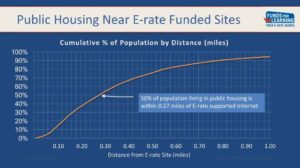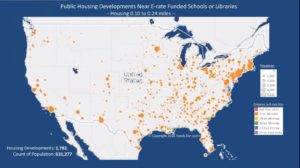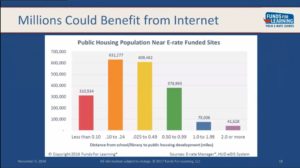Recently, I attended a webinar on E-rate and the Homework Gap. The presentation was part of the Schools, Health & Libraries Broadband Coalition’s Grow2Gig+ Webinar Series.
One of the speakers was John Harrington, CEO of Funds for Learning, who talked about e-rate regulations and the limitations they place on access. E-rate’s Modernization Order (2014) encouraged schools and libraries to improve wireless access in addition to the traditional services e-rate supports.
According to Funds for Learning’s analysis of FY2015 e-rate funding disbursements, support for schools’ internet access and WANs amounted to $32 per student and $8,321 per site. Many schools and libraries would like to use that significant investment to increase access to their communities. After all, their e-rate-funded wireless networks tend to be quiet after school hours and many homes are within range. The problem is e-rate rules don’t allow recipients to provide access to non-school or non-library locations.
Harrington shared a map and two graphs showing the potential benefits of expanding access to schools’ and libraries’ wireless networks. First is a graph showing how close public housing generally is to e-rate funded sites:
Next is a map showing locations of public housing developments near (0.10 to 0.24 miles) schools or libraries receiving e-rate funding.
The final graph shows the numbers of people living in public housing who could potentially receive access by proximity to a school or library.



